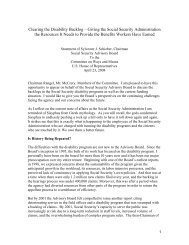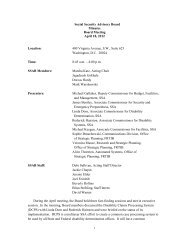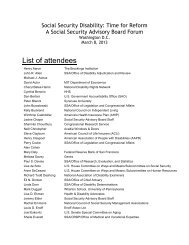Aspects of Disability Decision Making: Data and Materials
Aspects of Disability Decision Making: Data and Materials
Aspects of Disability Decision Making: Data and Materials
You also want an ePaper? Increase the reach of your titles
YUMPU automatically turns print PDFs into web optimized ePapers that Google loves.
effect <strong>of</strong> unrelated non-severe impairments.Following the 1987 decision <strong>of</strong> the Supreme Courtin Bowen v. Yuckert, where the Court upheld thevalidity <strong>of</strong> step 2, the plaintiffs amended their complaintto allege misapplication <strong>of</strong> the non-severest<strong>and</strong>ard. (By misapplication the Court meant thatSSA was using a st<strong>and</strong>ard at step 2 that denied disabilityclaims as not severe when the impairmentwas more than de minimis.) The district court foundthat SSA had misapplied step 2 as early as 1976.This led to a change in SSA policy regarding how theagency treats the combined effect <strong>of</strong> unrelated nonsevereimpairments in disability determinations.ISSUE: <strong>Disability</strong> Determination Services’(DDS’) Liability under 42 U.S.C. Section 1983A principal court case involving DDS liabilityunder section 1983 is Schoolcraft (MN).The plaintiffs alleged that the Secretary <strong>of</strong> HHS<strong>and</strong> the Minnesota DDS were not applying the samedisability evaluation st<strong>and</strong>ard at each stage <strong>of</strong> theadministrative process. Plaintiffs proposed that thecourt certify a class that would include all title II<strong>and</strong> title XVI disability claimants in Minnesota whohad not received a hearing decision. The districtcourt dismissed the claim on the grounds that thenamed litigants had not exhausted the administrativeremedies provided under the Social SecurityAct, i.e., they had not satisfied section 405(g)exhaustion requirements before going to court. The8 th Circuit reversed the district court’s decision. Thiscourt waived the exhaustion requirements underthe Supreme Court’s ruling in Bowen v. City <strong>of</strong> NewYork <strong>and</strong> also found that the plaintiffs had a cause<strong>of</strong> action against the State, under section 1983,which provides a basis for suits against agenciesacting under color <strong>of</strong> State law.A number <strong>of</strong> class action complaints (e.g., Miller,Kildare, Sorenson) have asserted jurisdiction underthis section. SSA has made numerous requests fora legislative change that would exempt the StateDDSs from liability under section 1983.ISSUE: Durational Requirement <strong>and</strong> TrialWork PeriodA principal court case involving the durationrequirement is Walton (4 th Circuit).The Social Security Act defines disability as the“inability to engage in any substantial gainful activity(SGA) by reason <strong>of</strong> any…impairment…which haslasted or can be expected to last for…not less than12 months.” SSA interprets this to mean that theinability to engage in SGA, not just the impairment,must last or be expected to last for 12 months. The4 th Circuit, however, in the Walton case, issued adecision on December 12, 2000 finding that a claimantis entitled to disability benefits if the impairmentmeets the death or 12 month duration requirement(in direct contrast to SSA’s interpretation).Walton also raised another issue: whether aclaimant, who engages in SGA within 12 months <strong>of</strong>onset <strong>of</strong> disability, <strong>and</strong> before final adjudication, isentitled to a trial work period. This issue had beenconsidered by the 10 th , 7 th , 8 th , 6 th , <strong>and</strong> 4 th Circuits<strong>and</strong> all ruled against SSA. They held that a trial workperiod is possible if the individual returns to workwithin 12 months <strong>of</strong> onset provided that the returnto work did not occur before the end <strong>of</strong> the 5-monthwaiting period.SSA appealed the courts’ decisions to theSupreme Court. In March 2002 that Court held thatthe agency’s interpretations <strong>of</strong> the statute fell withinits lawful interpretative authority. Justice Breyernoted that the Administration has determined inboth its formal regulations <strong>and</strong> its interpretation <strong>of</strong>those regulations that an “inability” must last thesame amount <strong>of</strong> time as an “impairment,” or last orbe expected to last not less than 12 months.ISSUE: AcquiescenceA principal court case involving acquiescence isStieberger (NY).Since 1985, SSA has had an acquiescence policythat it reviews all circuit court decisions to determinewhether the decision contains any holdingsthat conflict with SSA’s interpretation <strong>of</strong> the SocialSecurity Act or regulations. If a conflict is identified,an acquiescence ruling is published in theFederal Register that explains how SSA will applythe holding.Over the years SSA has made incrementalrefinements to improve its acquiescence process,including a 1990 expansion <strong>of</strong> the policy to involveall levels <strong>of</strong> the adjudication process. An explanation<strong>of</strong> its acquiescence policy is codified in theregulations (20 CFR 404.985 <strong>and</strong> 416.1485).As part <strong>of</strong> its Process Unification initiative, SSAissued SSR 96-1p restating its longst<strong>and</strong>ing acquiescencepolicy. Examples <strong>of</strong> acquiescence rulings thatrequired changes to regulations to restore uniformityto national policy include:■■Haddock (AR 00 – 3(1)) – Discusses whether,when evaluating vocational expert testimony insupport a finding <strong>of</strong> “no disability,” an ALJ mustask the vocational expert if his or her testimonyis consistent with the Dictionary <strong>of</strong> OccupationalTitles.■■Curry (AR 00- 04(2)) – Describes the burden<strong>of</strong> proving residual functional capacity at step 5<strong>of</strong> the sequential evaluation process.102 <strong>Aspects</strong> <strong>of</strong> <strong>Disability</strong> <strong>Decision</strong> <strong>Making</strong>: <strong>Data</strong> <strong>and</strong> <strong>Materials</strong>









